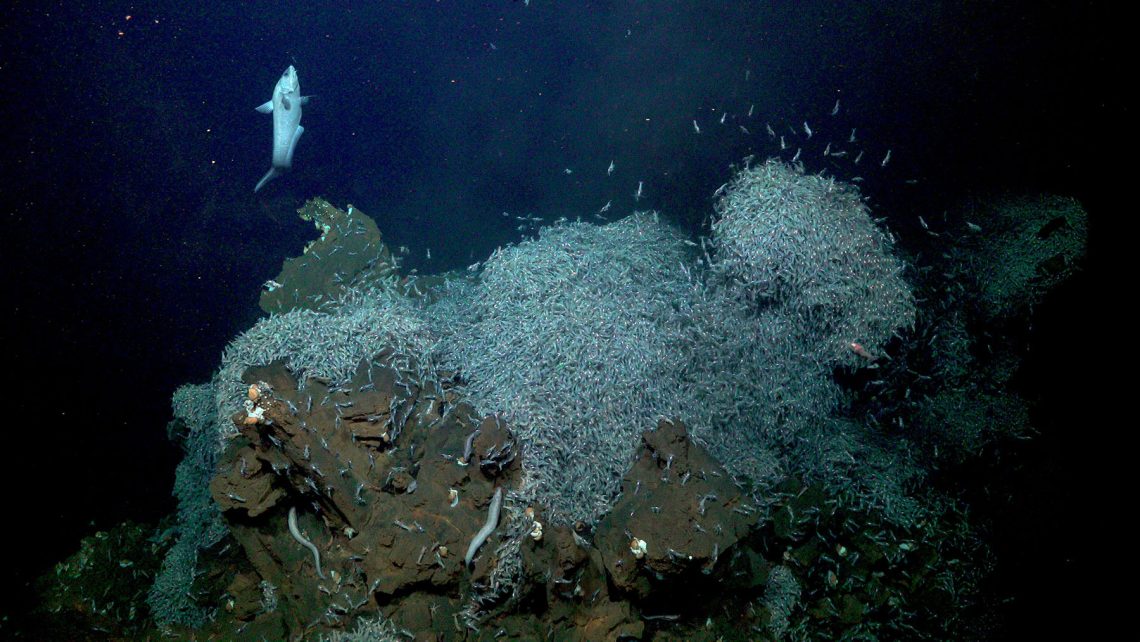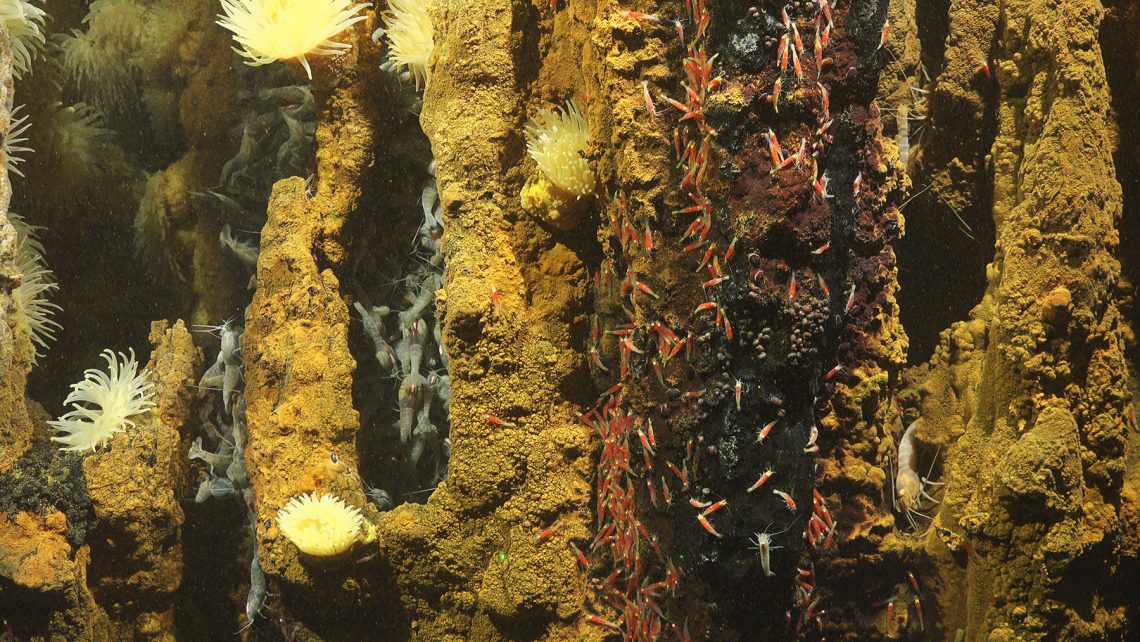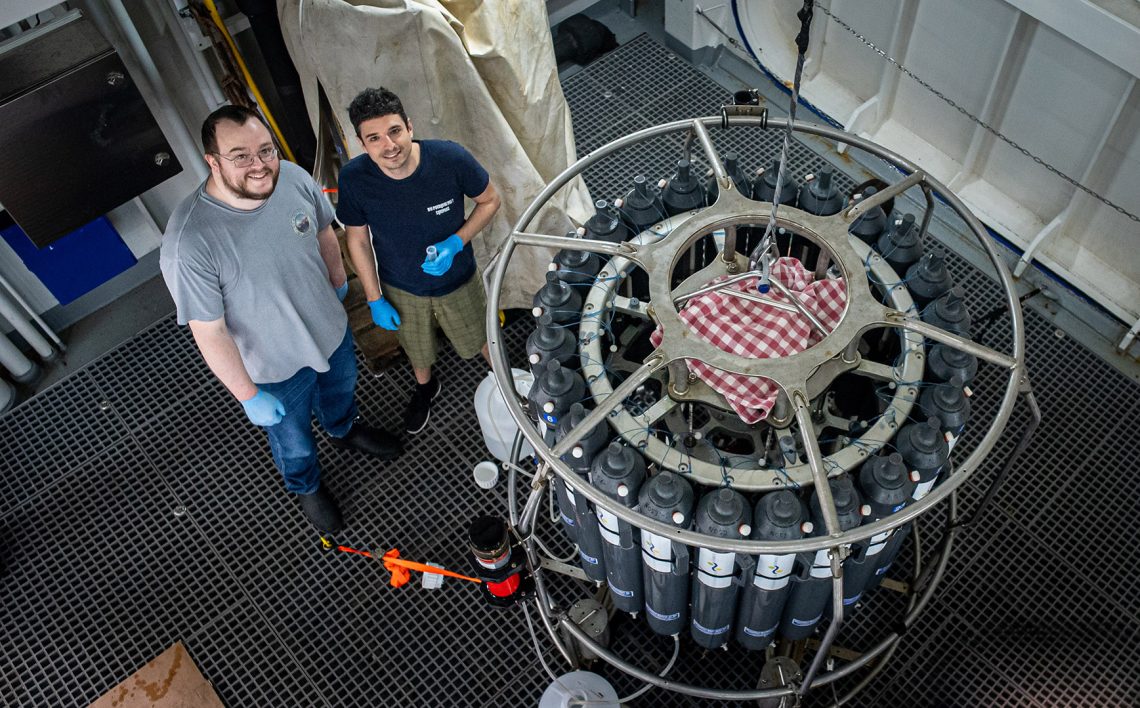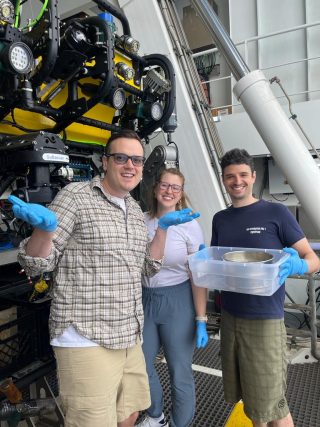Some of the most striking features of the deep sea are the amazing oases of life found at sites of hydrothermal venting. Elsewhere in the deep ocean, there is a low density of animals due to the fact that food is less abundant with depth, and thus, there is not enough energy to sustain a large density of animal life. In terrestrial, freshwater, and shallow marine ecosystems, organic matter is produced by plants, algae or phytoplankton through photosynthesis. Using light, photosynthetic organisms are able to fix carbon dioxide and produce organic matter (carbon) for growth, which then feeds into the rest of the food web. This process is at the base of ecosystems and supports the many animals we observe in our daily lives. However, light does not penetrate deeper than 200-500 m in the ocean, and thus photosynthesis is not an option at greater depths. One of the few exceptions to this scarcity-of-food rule are deep-sea hydrothermal vent habitats. But how?
At hydrothermal vents, seawater chemically altered through water-rock interactions at high temperature is expelled back through smokers and areas of diffuse fluid. This water is enriched in certain chemical compounds, such as hydrogen sulfide and methane, providing reduced foods for microbial growth in a process known as chemosynthesis. In short, if photosynthesis is the production of energy using light, chemosynthesis is the production of energy using chemical compounds. These bacteria are at the base of the lush hydrothermal animal communities that radically contrast with the majority of the deep sea. Moreover, the flagship animal species that visually dominate vent communities, such as tube worms, mussels, or shrimps, usually present symbiotic relationships with chemosynthetic bacteria. In other words, these animals harbor bacteria that grow from chemicals and pass the production of carbon back to the host. It is an analogous relationship to that of the colorful corals with algae in shallow tropical reefs. On top of chemosynthetic bacteria and large animals, many other smaller species thrive by feeding on bacteria or other animals, thus creating the dense communities observed at vents. The majority of vent species are not found elsewhere in the ocean, hence, for these animals, hydrothermal vents are tiny island refugia in a hostile deep sea.

Hydrothermal vent animals disperse by producing an enormous amount of larvae into the water column, allowing them to be taken away by ocean currents in the hopes that they will settle at another vent, thus ensuring the viability of the population. How they are able to settle and thrive at these small oases separated by 10’s to 100’s of kilometers along the vast deep sea mid-ocean ridge is still not well understood. Also, hydrothermal vents can have very different chemical features, only some of which may be favorable to certain animals. Ultimately, this may produce striking differences in the observed animal communities because some species are better adapted to specific environments than others.

Our expedition aims to discover a very special type of vent. So far only one of these vents is known in the Mid-Atlantic Ridge: the Lost City. In contrast to acidic, metal-rich, high-temperature black smokers linked to volcanism, Lost City shows alkaline (basic), metal-poor, white smokers where hydrothermalism is linked to a water-rock reaction called serpentinization (blog #1). Little information is available on the animal communities that colonize Lost City. How are the animals at Lost City related compositionally to other hydrothermal vents? Is there connectivity between vents like the Lost City? It is difficult to know when there is only one known vent site for comparison. While our search for such systems is still continuing on this cruise (blog #2), we have found some new and exciting deep-sea hydrothermal vents and collected a number of interesting animal samples. On top of the well-known, yet always mesmerizing, swarms of shrimps and dense anemone aggregations, we have found some unexpected and exciting findings. We have repeatedly observed enigmatic dense aggregations of gastropods only reported very recently in the scientific literature. Furthermore, we have observed unusual and dense aggregations of fish in warmer vent waters, and these will be the focus of further studies.


Typically, we collect organisms that we can see, grab, scoop, or suction, all excellent methods for observing and collecting larger/immobile animals (mussels, tube worms, crabs), small mobile animals (shrimp), or microbial mats. These methods are important as the foundation for our understanding of the vent ecosystem, since many species are uncharacterized and unknown outside of these environments. However, it is also now possible to use non-destructive molecular methods to detect and characterize vent animal assemblages from the water flowing above them. Environmental DNA (eDNA) is extracted from cell material either sloughed from animals or from the microbes and animals themselves present in the water column. Using eDNA, we can amplify marker genes and identify all these animals to better understand the whole hydrothermal ecosystem, including charismatic larger animals and the microbes and smaller animals that support them in a complex food web. Usually, obtaining results from this kind of molecular approach can take a year to complete on land. Onboard this expedition, where we can prioritize these samples and with an onboard Oxford Nanopore sequencer, we can learn about the biological community within a few short days. Overall, the methods we are using onboard allows us to understand the connectivity of animals at deep-sea hydrothermal vents almost as fast as we can discover them!
Authors: Joan Alfaro-Lucas1 & Sean M. McAllister2
1 University of Victoria (UVIC), Canada
2 National Oceanographic and Atmospheric Administration – Pacific Marine Environmental Laboratory (NOAA -PMEL), USA/University of Washington – Cooperative Institute for Climate, Ocean, & Ecosystem Studies (UW-CICOES)
Traducción Española
Algunos de los hábitats más llamativos de las profundidades marinas son los asombrosos oasis de vida asociados a las fuentes hidrotermales. En otras partes del océano profundo, hay una baja densidad de animales debido al hecho de que la comida es menos abundante a medida que aumenta la profundidad y, por lo tanto, no hay suficiente energía para sostener una gran densidad de vida animal. En los ecosistemas terrestres, de agua dulce y marinos poco profundos, la materia orgánica es producida por plantas, algas o fitoplancton a través de la fotosíntesis. Usando luz, los organismos fotosintéticos pueden fijar dióxido de carbono y producir materia orgánica (carbono) para su crecimiento, que luego alimenta al resto de la red trófica. Este proceso es la base de los ecosistemas y sustenta a los muchos animales que observamos en nuestra vida diaria. Sin embargo, la luz no penetra a más de 200-500 m en el océano y, por lo tanto, la fotosíntesis no es una opción a mayores profundidades. Una de las pocas excepciones a esta regla de escasez alimentaria son los hábitats asociados a las fuentes hidrotermales. ¿Pero por qué?
En las fuentes hidrotermales, el agua de mar químicamente alterada por las interacciones agua-roca a altas temperaturas es expulsada a través de chimeneas negras y áreas de fluido difuso. Esta agua está enriquecida con ciertos compuestos químicos, como el sulfuro de hidrógeno y el metano, lo que proporciona alimento para el crecimiento microbiano en un proceso conocido como quimiosíntesis. En pocas palabras, si la fotosíntesis es la producción de energía a partir de la luz, la quimiosíntesis es la producción de energía a partir de compuestos químicos. Estas bacterias forman la base de las exuberantes comunidades de animales de fuentes hidrotermales que contrastan radicalmente con la mayoría de las profundidades marinas. Además, las grandes especies animales emblemáticas que dominan visualmente las fuentes hidrotermales, como gusanos tubícolas, mejillones o camarones, suelen presentar relaciones simbióticas con bacterias quimiosintéticas. En otras palabras, estos animales albergan bacterias que crecen a partir de productos químicos y pasan la producción de carbono al huésped. Es una relación análoga a la que tienen los coloridos corales con algas en los arrecifes tropicales poco profundos. Además de las bacterias quimiosintéticas y los grandes animales con relaciones simbióticas, muchas otras especies animales más pequeñas prosperan alimentándose de bacterias u otros animales, creando así las densas comunidades que se observan en las fuentes hidrotermales. La mayoría de las especies hidrotermales no se encuentran en ningún otro lugar del océano, por lo tanto, para estos animales, estas fuentes son pequeñas islas en un mar profundo hostil.
Los animales hidrotermales se dispersan lanzando una enorme cantidad de larvas a la columna de agua, lo que permite que las corrientes oceánicas se las lleven con la esperanza de que se asienten en otra fuente, asegurando así la viabilidad de la población. Todavía no se comprende bien cómo pueden establecerse y prosperar en estos pequeños oasis separados por decenas o cientos de kilómetros a lo largo de las vastas dorsales en medio del océano. Además, las fuentes hidrotermales pueden tener características químicas muy diferentes, sólo algunas de las cuales pueden ser favorables para ciertos animales. En última instancia, esto puede producir diferencias sorprendentes en las comunidades animales observadas porque algunas especies se adaptan mejor a entornos específicos que otras.
Nuestra expedición tiene como objetivo descubrir un tipo de fuente hidrotermal muy especial. Hasta ahora, solo se conoce una de estas fuentes en la dorsal oceánica del Atlántico: Lost City (la Ciudad Perdida, en inglés). En contraste con las chimeneas negras con fluidos ácidos, ricos en metales y de alta temperatura vinculados al vulcanismo, Lost City muestra chimeneas blancas alcalinas (básicas), pobres en metales, donde el hidrotermalismo está vinculado a una reacción agua-roca llamada serpentinización (blog #1). Hay poca información disponible sobre las comunidades de animales que colonizan Lost City. ¿Qué tan parecidas son las comunidades faunísticas de Lost City con otras fuentes hidrotermales? ¿Hay conectividad entre fuentes hidrotermales como Lost City? Es difícil tener respuestas cuando solo hay una fuente conocida para comparar. Si bien nuestra búsqueda de tales sistemas aún continúa en este crucero (blog #2), hemos encontrado algunas nuevas y emocionantes fuentes hidrotermales y ya hemos recolectado una serie de muestras de animales interesantes. Además de los conocidos, pero siempre fascinantes, enjambres de camarones y las densas agregaciones de anémonas, hemos encontrado algunos hallazgos inesperados y emocionantes. Hemos observado repetidamente agregaciones densas y enigmáticas de gasterópodos sólo reportadas muy recientemente en la literatura científica. Además, hemos observado agregaciones inusualmente densas de peces en las aguas cálidas de fuentes hidrotermales que serán el foco de estudios futuros.
Por lo general, recolectamos organismos que podemos ver, agarrar, sacar o succionar. Todos estos métodos son excelentes para observar y recolectar animales grandes e inmóviles (mejillones, gusanos tubícolas, cangrejos), pequeños animales móviles (camarones) o incluso tapetes microbianos. Estos métodos son importantes para nuestra comprensión del ecosistema hidrotermal, ya que muchas especies no están caracterizadas y son desconocidas fuera de estos entornos. Sin embargo, ahora también es posible usar métodos moleculares no destructivos para detectar y caracterizar estas comunidades hidrotermales a partir del agua que fluye por encima de ellos. El ADN ambiental (eDNA, en inglés) se extrae del material celular que se desprende de los animales, o de los propios microbios y animales presentes en la columna de agua. Usando el eDNA, podemos amplificar genes marcadores e identificar a todos estos animales para comprender mejor todo el ecosistema hidrotermal, incluidos los animales carismáticos más grandes, los microbios y los animales más pequeños que los sustentan la compleja red trófica. Por lo general, la obtención de resultados en este enfoque molecular puede tardar un año en completarse en tierra. En esta expedición, podemos priorizar estas muestras y con un secuenciador Oxford Nanopore a bordo, podemos aprender sobre la comunidad biológica en muy poco tiempo (días). En general, los métodos que estamos utilizando a bordo pueden permitirnos comprender la conectividad de las fuentes hidrotermales casi tan rápido como podemos descubrirlos!
Figura 1. Una amalgama de camarones Rimicaris exoculata compitiendo por energía química para sus simbiontes en la cima de una fuente hidrotermal recién descubierta en Grappe Deux.
Figura 2. Muchos grupos de especies de fuentes hidrotermales distintas viviendo donde están mejor adaptadas. Cada vez que observas la imagen descubrirás algo nuevo incluyendo: caracoles, camarones y tapices microbianos.
Figura 3. Sean McAllister (izquierda) y Joan Alfaro (derecha) al lado del instrumento de conductividad/temperatura/profundidad (CTD, en inglés) después de colectar eDNA de la columna de agua y organismos con el robot remotamente operado (ROV, en inglés) SuBastian.
Figura 4. De izquierda a derecha: Jeff Beeson, Megan Davies y Joan Alfaro recolectando rocas y organismos de fuentes hidrotermales colectadas con el robot remotamente operado (ROV, en inglés) SuBastian.


